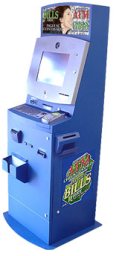Payment Kiosks
Payment kiosks are actual physical terminals that you see at the back or side of a prepaid wireless dealer or corporate owned store. The first topup kiosks looked a lot like ATMs or lottery machines, however, the newer ones are much more interesting. They have much larger screens and interesting, eye-catching shapes. The latest ones are also usually touch screens and have rich graphics often playing videos on the idle screen when not in use.
Some benefits of kiosks include:
- Self -service means you don't have to line up. Some prepaid wireless stores find themselves with long waits to get personalized service from a store representative.
- Often provide other bill payment services. For example, you may be able to pay other utility or even car payments at the same kiosks like your water, electric, or cable bills.
- Cheaper for stores because a clerk doesn't have to spend the time to make the sale. What this means from a customer perspective is that kiosks are often the first to get special topup promotions to encourage people to self-serve.
So how does it work?
- The features of payment kiosks in terms of card activations, PINs, and topup are identical to those of Web Terminals. The only difference is that it is a self-service process instead of the sales clerk processing the transaction. on behalf of the you, the customer.
It's interesting to note that some people debate that self-service applications actually take away the opportunity for a sales clerk to up sell you to buy other things in the store like accessories or a more expensive plan. It's also fair to point out, though, that when lines are long, customers are more likely to leave the store rather than wait in line to replenish. With the kiosk in place, the customer can self serve without getting frustrated and leaving to replenish somewhere else. However, that said, I've also heard that some high traffic stores will often have long lines at the kiosk, which completely destroys that benefit!
Most payment kiosks don't accept or give change. What this means is that if you want to make a payment to your prepaid wireless account for $35.50, you'll need to insert cash totaling $36. Don't worry, though, the extra $0.50 is simply applied to your account. Depending on your wireless carrier, this additional money would either be a credit towards your next payment, or you would simply have $0.50 extra (in this example) on your prepaid account balance. In other words, you're not losing anything! Of course, if you pay with a credit or debit card, you can pay the exact amount that you wish to apply to your prepaid account.
Also note that some carriers require a minimum payment (ex. $10), such that the first bill you insert into the machine would have to be a $10 bill. You could not insert 10 $1 bills, nor two $5 bills, even though they total the required $10. The reason for this is that the machine cannot return the cash to you, and if you only insert one or two dollars, the minimum payment requirement cannot be guaranteed. I've see. carriers work around this by making exceptions on kiosks and allowing $1 payments.
Lastly, note that inferred from this discussion is that most machines don't give change either (bills or coins), so whatever you insert into the machine gets applied to your account. So don't put in two $50 bills wanting to add $65, and expecting to get $35 back! Although there are some change giving machines, they tend to be much more expensive to build and maintain, such that the industry in general doesn't want to purchase them or deal with maintaining them. At the end of the day, I don't see this as a major issue, however, it can result in some minor frustrations for some customers. Knowing to look out for these things in advance will most certainly help you through your first payment kiosk experience.
Home
›
Point Of Sale Technology
›
Payment Kiosks
| Be Heard! Let prepaid wireless providers know what you want; fill out the survey now. |



Comments
Have your say about what you just read! Leave a comment in the box below.